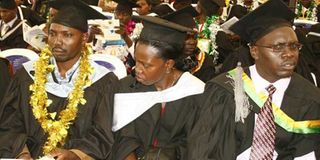Varsities open doors for more students

Some of the students who graduated at Jaramogi Oginga Odinga University of Science and Technology in Bondo on May 9, 2014. Public universities will admit 5,000 more students in 2014. PHOTO | JACOB OWITI
What you need to know:
- Entry grades lowered to B for males and B- for females, paving the way for 5,000 more freshers this year
- Under the new admissions procedure, attempts will be made to ensure gender and regional equity
About 58,000 candidates who sat the Kenya Certificate of Secondary Education last year will get places in public universities after the lowering of entry requirements by the newly-established body responsible for admitting students to higher education institutions.
In an advert in the local dailies, all students seeking admissions to degree and diploma programmes will for the first time be admitted simultaneously through a central agency known as Kenya Universities and Colleges Placement Service.
In the past, universities and colleges admitted students separately. Universities used the Joint Admission Board (Jab), an informal body established by vice chancellors of public universities while colleges had their own admission systems.
In the new developments, the admission agency has lowered entry requirements to B- for females and B for males seeking university places with a cut-off point of 58 and 60 respectively. In addition, candidates with a minimum overall grade of C- are eligible to apply for diploma programmes.
The new agency will place the diploma students in Technical and Vocational Education training institutions — a first in the post Joint Admission Board era.
Overall, a total of 232,699 candidates obtained a mean grade of C- and above in last year’s KCSE. The total candidature was 449,216.
The current intake is 5,000 more than the last year’s.
The chairman of the new admission body, Prof David Ndetei, says the objective of the new intake system was to allow many university qualifiers to get places, while ensuring efficiency and fairness.
Under the new admissions procedure, attempts will be made to ensure gender and regional equity. For example, deliberate attempts will be made to ensure that more female students join courses such as engineering, medicine and other technology-based disciplines, which are dominated by males.
Similarly, efforts will be made to get more males join courses such as nursing at the diploma level, which generally attract more females.
“Our admission system has been designed to ensure equity and fairness in terms of gender, region, physical abilities and courses,” said Prof Ndetei. “The objective is to give each qualifier a chance to pursue a course of his or her interest and ability without discrimination.”
The new agency was established early this year in line with the provisions of University Education Act 2012. It takes over from JAB that never had a legal mandate.
DETERMINING FEES
The Act has also provided for University Financing Board, which has not been established, but is intended to take charge of university funding, including determining fees and helping universities with fund raising.
In the 2012 KCSE , some 53,000 candidates were picked to join public universities.
The college and university reporting dates of last year’s candidates will be announced by respective universities and colleges. Candidates who met the cut-off points can access their admission information from Kenya Universities and Colleges Placement Service website kuccpsonline.uonbi.ac.ke





